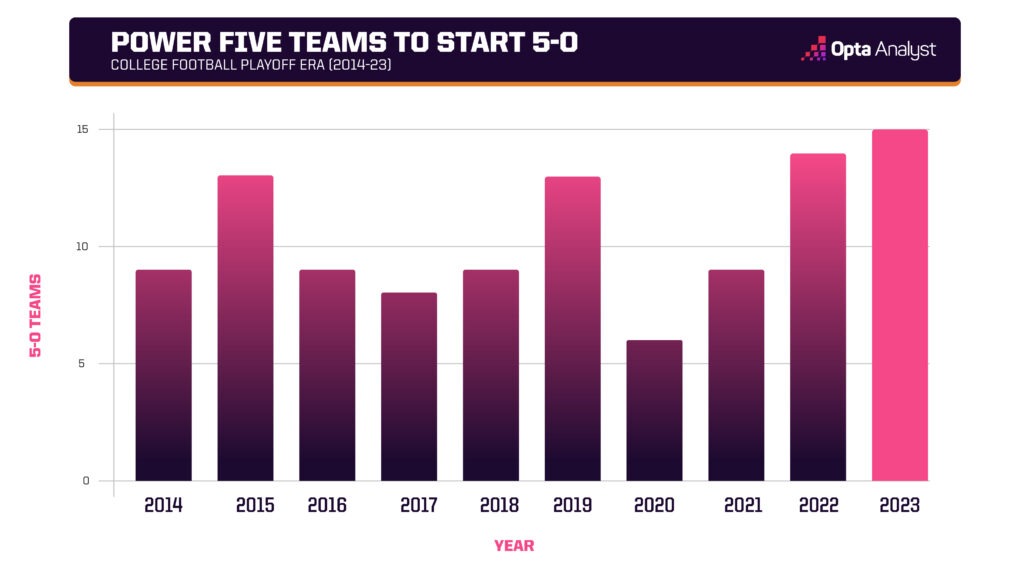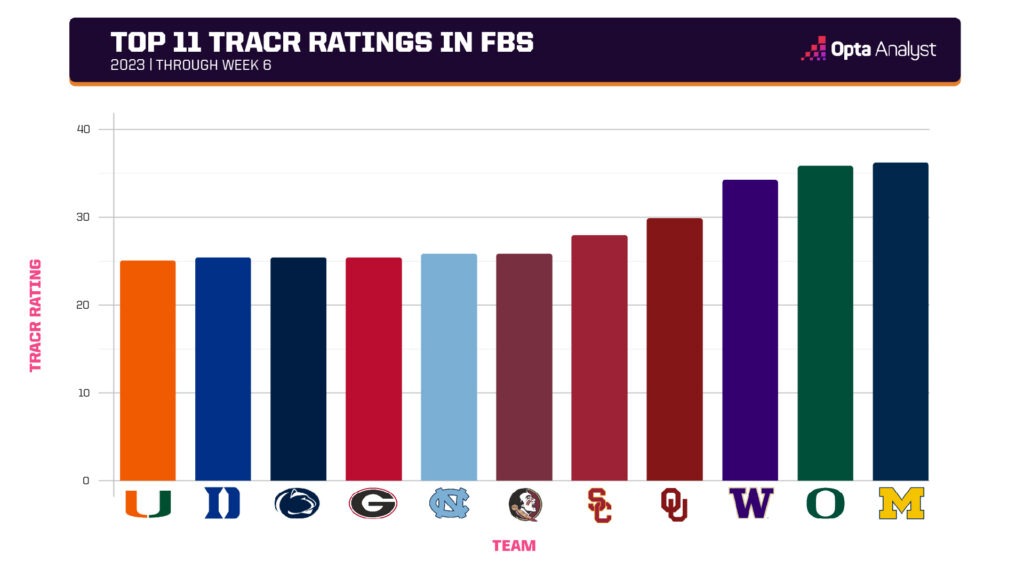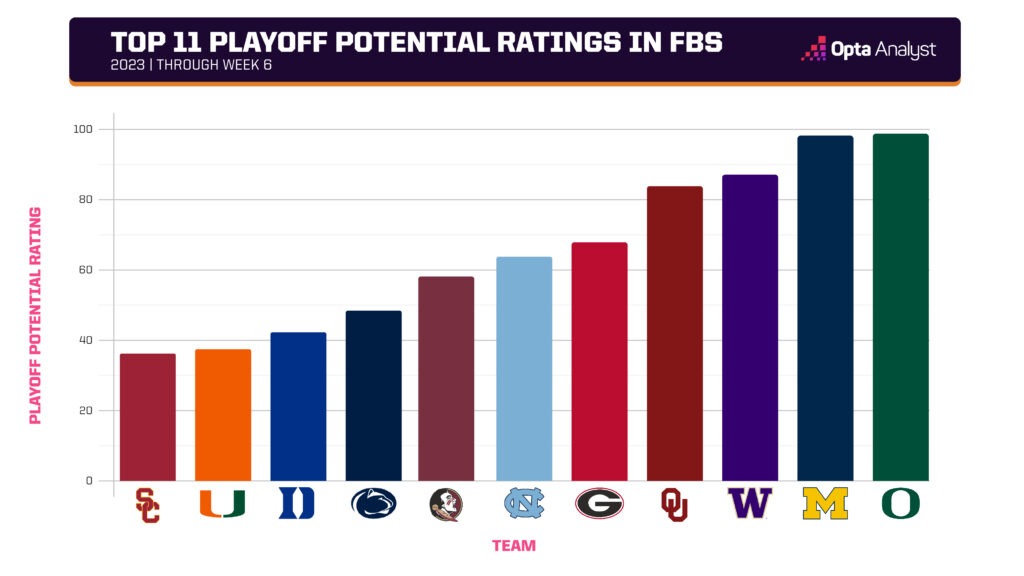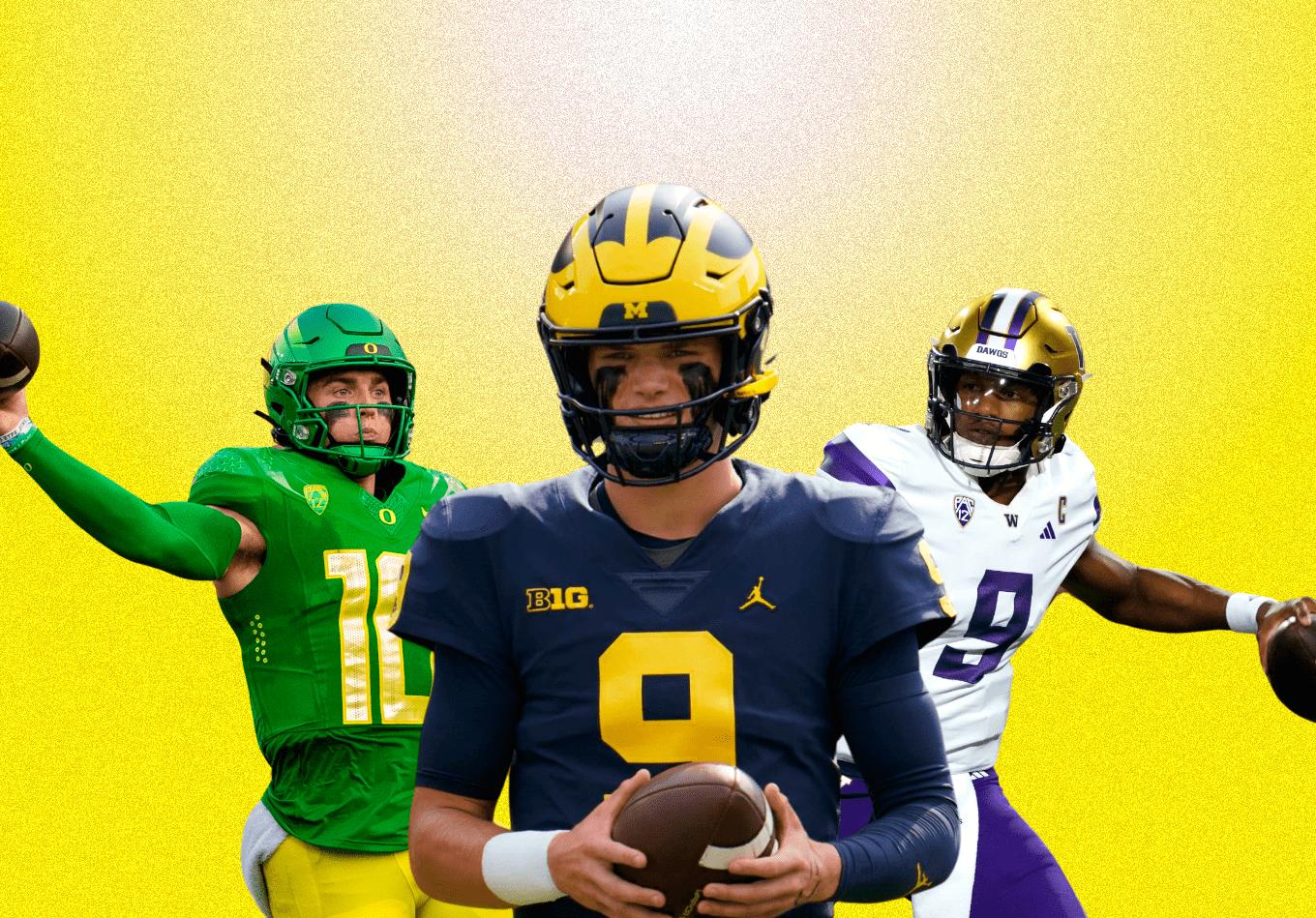For obvious reasons, the 2023 season is the end of an era in college football as we know it.
And it’s not just about realignment – though we might have a hard time getting used to seeing UCLA and USC in the Big Ten, or Oklahoma and Texas in the SEC. But the most significant change that impacts teams nationwide is that this year is the 10th, and final, season of the four-team playoff era, before the College Football Playoff (CFP) expands to 12 spots in 2024.
This much, we already knew entering the start of the season. But what we didn’t know was that the final playoff race of the four-team era could very well be the best one yet. Is this indeed the most wide-open race of the CFP era?
At least based on the eye test, most of the college football world thinks so. In contrast to a team like Georgia last season, or the Alabama and Clemson dynasties of the mid-late 2010s, most fans and media have the consensus opinion that there aren’t any “juggernaut” teams that are essentially locks to make the CFP.
But do the numbers actually support this narrative?
Short answer: yes.
Let’s start with the most basic stat in the book: win-loss record. This season, a staggering 15 teams from Power 5 (P5) conferences started 5-0: Florida State, Georgia, Kentucky, Louisville, Maryland, Michigan, Missouri, UNC, Ohio State, Oklahoma, Oregon, Penn State, Texas, USC and Washington. (Kentucky, Maryland, Missouri and Texas have since lost, but a cut-off of five games was used because not every team listed has played a sixth game yet.)
If this sounds like a lot, it is. As a matter of fact, since the Big East dropped football after the 2012 season (creating the current “Power 5” as we know it), that’s the most such teams to start 5-0 in a single year, and only the fourth season in the CFP era with more than 10 such teams.

Of course, we know that not all of the remaining unbeaten squads will finish as such. As a matter of fact, at least one is guaranteed to fall from the ranks of perfection this weekend when Oregon takes on Washington in a rematch of an instant classic from last year. But even after several of the unblemished records fall, there still will be an opportunity for this season to make history.
There are currently 11 undefeated Power 5 teams, but perhaps more impressively, each of the Power 5 conferences has at least one. (Three conferences have three perfect squads apiece: the Pac-12, ACC and Big Ten.)
Because it’s obviously impossible for any P5 conference to finish with multiple unbeaten teams due to the presence of conference championship games, this balance between the conferences is important, as it’s theoretically still in play for every P5 conference to finish with an unbeaten team entering bowl season.
We can be honest with ourselves: that won’t happen. The sport is simply too volatile for “chalk” to hold the rest of the way in this manner. But if even three or four of the conferences have their champion make it out unscathed, that would still be breaking precedent.
Since 1998 (the start of the BCS), the record for the most undefeated teams from power conferences entering bowl season is three – 2004 (USC, Oklahoma, Auburn), 2009 (Alabama, Texas, Cincinnati) and 2019 (LSU, Clemson, Ohio State).
If we expand this to the entire FBS, the record over the same time span is five undefeated teams, done in 2004, 2009 and 2020 (though that was a COVID-shortened season). There are currently three undefeated “Group of 5” teams in 2023, all coming from different conferences: Air Force (Mountain West), James Madison (Sun Belt) and Liberty (C-USA).
As such, whether we consider just the P5 or the nation as a whole, 2023 has the opportunity to create a logjam of undefeated teams the likes of which we’ve never seen. For what it’s worth, our projection model has six undefeated teams that individually have at least a 20% chance to win out in the regular season: Michigan, Oklahoma, Air Force, Oregon, Georgia and Washington.
Win-loss record doesn’t tell the entire story of the playoff picture, as die-hard fans of the college game know, since it’s very possible for a team’s record to be a poor representation of its overall ability (in either direction). To account for this, we can dive deeper into our TRACR rankings.
TRACR (Team Rating Adjusted for Conference and Roster) is an all-encompassing metric that accounts for how good a team is on a play-to-play basis, relative to the opponents it plays. A rating of zero is considered to be the FBS average, and the gap between any two teams’ ratings is the expected score differential if those teams played at a neutral site (e.g., if Team A’s TRACR was 14.5, and Team B’s was 11.5, we’d expect Team A to beat Team B by three points).
And as you might guess, the 2023 TRACR ratings show a lot of parity at the top. TRACR is generally very high on the Pac-12, with three of the top five teams (Oregon, Washington, USC) hailing from there, but in general, there is no shortage of playoff contenders nationwide.
For example, the teams in fourth place (Oklahoma) and 11th place (Miami, despite last week’s extremely avoidable loss) are within fewer than five points of one another, creating a very crowded set of teams that could be considered in the nation’s top tier.

What does this actually mean for the playoff picture? To dive into this, let’s take a look at our first playoff potential ratings (PPR) of the 2023 season. It’s a strength of record metric, meant to compare any given team’s record to what record we’d expect the nation’s top team to have if it played the exact same schedule.
To clarify, this does NOT mean playoff potential rating is equivalent to a team’s probability to make the playoff – for example, you absolutely shouldn’t interpret Michigan’s 99 PPR as us saying the Wolverines have a 99% chance to reach the CFP. While the metric’s general purpose is to gauge each team’s potential to be a playoff team, it is not scaled in a percentage format in this manner.
For the sake of comparison, as shown in the above link about PPR published in mid-November 2022, there was an absolutely massive gap between the “haves” and “have-nots” at the time. Six teams had a PPR of at least 88 (eventual CFP participants Georgia, TCU, Ohio State and Michigan, along with Alabama and Tennessee), while the next-closest team was way down at approximately 56 (Kansas State).
This year, there’s no such gap. Check out the top 11 teams in PPR – which happen to be the same as the top 11 teams in TRACR, though not ranked in the exact same order – in the below graph.

While one could say there’s a decent jump between No. 4 Oklahoma and No. 5 Georgia (which was at a surprisingly low 67, largely due to a schedule that was much easier in the first half of the season than it will be going forward), for the most part, the story is the same as is suggested by most other metrics and the eye test: a lot of teams are in the mix.
As such, in this final season of college football as we know it, very little is certain. A plethora of undefeated teams are still sincere playoff contenders, not to mention that you can’t count out one-loss squads like Alabama and Texas.
All that we know for sure is that whichever four teams get in will absolutely have earned it on the field, in what just might be the most exciting second half of a season the sport has seen in a long time.
Check out our complete college football season predictions. And follow us on X and Instagram for more.
